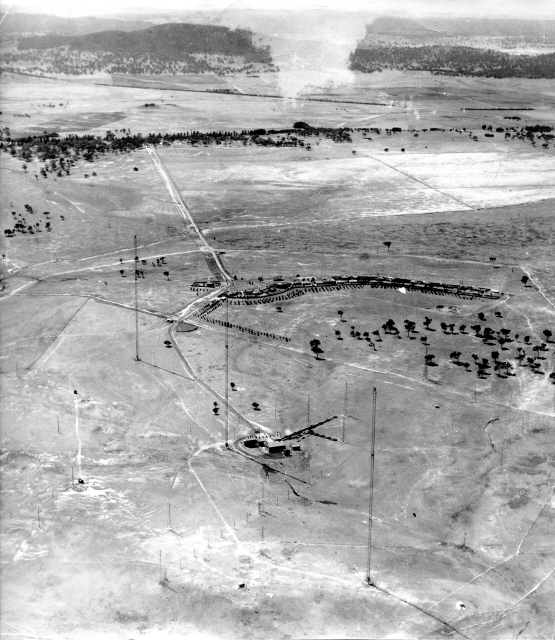
When established on April 20 1939 the RAN Transmitting Station at Belconnen, the most powerful short wave naval wireless station in the Commonwealth and the largest naval or commercial station in the southern hemisphere. It played a significant part in the defence of the Australian mainland during the tumultuous years of World War II, and later sent vital communications to RAN ships throughout the Korean and Vietnam conflicts and as recently as operations in the Gulf.
The Belconnen Naval Transmitting Station (BNTS as it was once known in the RAN) is located in the Canberra suburb of Lawson, 10 kilometres north-west of Canberra’s central business district and in the district of Belconnen. It originally comprised three main aerial masts, elements of the Rhombic and Omni Vector aerial arrays, a transmitting hall, guard post and guard house. There was also a cricket pitch and a village site. The site also included tree plantings, shelter belt radiata plantations, subdivision, tennis courts and a road system.
The wireless station was conceived in 1924 when a (British) Imperial Defence Committee advocated the modernisation of coastal radio stations in Australia and Rabaul to provide suitable Naval wireless facilities in the Pacific. In 1925, the Australian Commonwealth Naval Board (ACNB) recommended the establishment of “strategic wireless stations” at Canberra (for security reasons, 75 miles from the coast was deemed necessary) and Darwin.
In 1937, the Commonwealth Government authorised construction of both transmission and receiving stations in Canberra. They were 20 kilometres (12 mi) apart to overcome radio interference. Construction of the BNTS began in November 1938, followed months later by work on the receiving station that became HMAS Harman in 1943. BNTS was officially opened on April 22, 1939 and the first operational transmission was made 6 months later.
The BNTS used a very powerful 200 kiloWatt transmitter operating in the low-frequency spectrum. It was sufficiently powerful that, in conjunction with Rugby in England, communications were possible with merchant and naval or Fleet shipping anywhere in the world. It also serviced submerged submarines far into the Pacific and Indian Oceans. Its most visible feature was three 600-ft high masts set a quarter-mile apart that supported a massive radiating aerial. Such was the transmitter’s electromagnetic induction power that an isolated hand-held household fluorescent tube would light up in its vicinity. At full-bore, it generated so much heat that its output valves had to be water-cooled to prevent meltdown.
Short-Wave (High/Frequency) transmitters – two 20kW and one 10kW – were also installed and augmented at the station. Some of these H/F transmitters were used to provide a ship-to-shore service.
The many aerial arrays at BNTS made excellent targets for lightning storms. At certain times of the year, when storms were prevalent, it was both exhilarating and scary as lightning blasted around the transmitter room, with occasional fatal results for some transmitters.
During WWII around 200 RAN personnel operated the wireless stations. They included telegraphists, teleprinter operators, coders and writers (clerks) personnel from the RAN Shore Wireless Service, RANR, RANVR, WRANS and even the US Navy. The telegraphist operators at BNTS sent Morse-code messages – previously encrypted by `coders’ for secrecy and mostly passed through Harman – to allied ships (navy and merchant) and bases around the world. Guard duties at the site were undertaken by soldiers.
Two villages adjacent to the BNTS and Harman provided accommodation for some of the staff. During the early days of BNTS 24/7 watch keeping duties, its remote location Canberraa’s small size weren’t conducive to an active social life for the villagers.
During more than 66 years of service as a major communication radio station BNTS served both military and civilian radio stations under at least seven different callsigns. In 1956 it broadcasted radio news and commentary about the Olympic Games in Melbourne to the world. At the height of its operation, the transmitter station contained 38 shortwave transmitters ranging in power from 10 kW to 40 kW, with 50 antenna systems.
The largest transmitter at BNTS ceased operation in September 1995, its functions transferred to the Harold E Holt Communications Station in Western Australia. Eight months later responsibility for the station was transferred from RAN to civilian personnel.
The last message was sent from Belconnen on 17 June 2005 and the facility was decommissioned. By then efforts to have the site included on the Commonwealth Heritage List had proved successful, with its listing occurring in June 2004. However, the tall masts were deemed a safety and ongoing maintenance liability and at approximately 4:00pm on December 20, 2006 all three structures crashed to the ground.
The BNTS site once occupied 143 ha of Commonwealth-owned land. A report in 2012 identified a need for decontamination. This and the presence of the endangered Golden Sun moth and a threatened small perennial herb, Ginninderra Peppercress, resulted in most of the land being identified for heritage (natural, cultural and technical) and nature conservation only, and its being off limits to the public. Some of the site has been developed to form the new Canberra suburb of Lawson.
Reference
Royal Australian Naval Transmitting Station, National Heritage Database



